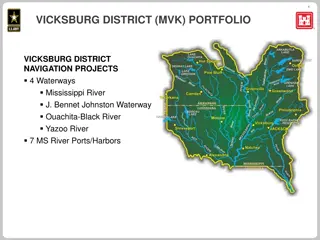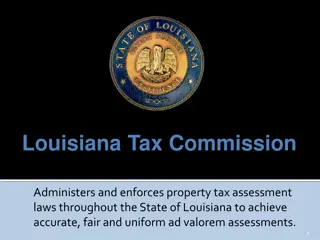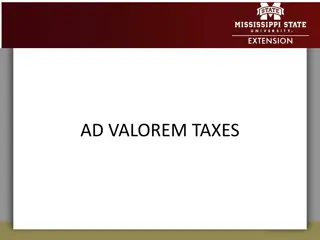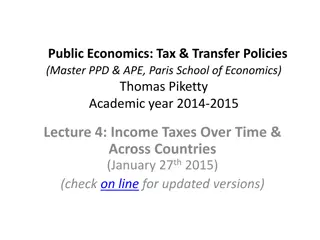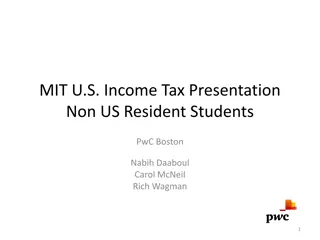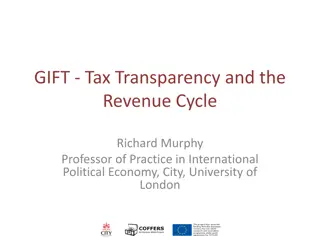AD VALOREM TAX IN MISSISSIPPI
Explores the intricacies of ad valorem tax in Mississippi as presented by Joe Young at the Stennis Institute of Government. Gain valuable insights into this tax system's application and implications through this informative presentation.
Download Presentation

Please find below an Image/Link to download the presentation.
The content on the website is provided AS IS for your information and personal use only. It may not be sold, licensed, or shared on other websites without obtaining consent from the author.If you encounter any issues during the download, it is possible that the publisher has removed the file from their server.
You are allowed to download the files provided on this website for personal or commercial use, subject to the condition that they are used lawfully. All files are the property of their respective owners.
The content on the website is provided AS IS for your information and personal use only. It may not be sold, licensed, or shared on other websites without obtaining consent from the author.
E N D
Presentation Transcript
AD VALOREM TAX IN MISSISSIPPI Presented by Joe Young Stennis Institute of Government
DEFINE AD VALOREM The phrase ad valorem is Latin for according to value
ROLE OF GOVERNING AUTHORITY 27-39-307 and 21-33-45 of the Mississippi Code of 1972 They shall have the power to levy such taxes as may be necessary to meet the demands of their respective municipality . . . not exceeding the limits that may be prescribed by law. . . .
AD VALOREM TAX SPENDING STATEWIDE AD VALOREM BREAKDOWN (RURAL) GARBAGE OTHER 3% GARBAGE COLLECT. 2% FIRE PROT. 1% JUNIOR COLLEGES 3% GENERAL COUNTY 32% INTEREST & SCHOOL 43% AD VAL 1 MILL 1% CONSTR. & MAINT. 11% . INTEREST & SINKING 4%
WHAT IS TAXED? 10% - Class I Single Family Owner Occupied Residential 15% - Class II All Real Property not classified Class I 15% - Class III Business Personal Property 30% - Class IV Public Utilities 30% - Class V Motor Vehicles
WHAT IS TRUE VALUE? True value is defined in 27-35-50 of the Code: True value shall mean and include, but shall not be limited to, market value, cash value, actual cash value, property value and value for the purposes of appraisal for ad valorem taxation. . . . In arriving at the true value of all Class I and Class II property and improvements, the appraisal shall be made according to current use, regardless of location. In arriving at the true value of any land used for agricultural purposes, the appraisal shall be made according to its use on January 1 of each year, regardless of its location; in making the appraisal, the assessor shall use soil types, productivity and other criteria. . . .
WHAT IS TRUE VALUE? (cont.) The point here is that true value and market value are not the same. Agricultural values, for example, can be much less than the actual market value of the property. Ownership and assessment of real property is as of January 1st of the tax year and payable the next year Example: Taxable: January 1, 2016 Payable: December 26, 2016 February 1, 2017
WHAT IS ASSESSED VALUE? The true value is multiplied by a ratio that is set by state law to yield the assessed value. The ratios are as follows: Class I Class II Class III Class IV Class V 10% 15% 15% 30% 30%
WHAT IS ASSESSED VALUE? (cont) It is necessary to understand the difference in market value, true value, and assessed value. Assessed value is used to determine everything from millage rates to salary levels for some county officials, including that of supervisors.
HOW ARE THE DIFFERENT CLASSES TAXED? Basic Formula True Value x % (Ratio set by law) Assessed Value x Millage Rate Gross Taxes
WHAT IS A MILL AND HOW IS IT CALCULATED? A Mill is a unit used in calculating money but is not a coin. A Mill is a tenth of a penny or a thousandth of a dollar. A tenth of one dollar or a dime is written $.10. A hundredth of one dollar or a penny is written $.01. One mill is a thousandth of one dollar and is written $.001.
Example: A Class II property has a true value of $75,000 and is in a taxing district in which the tax levy is 117.72 mills. Calculate the tax bill. 117.72 Mills = .11772 True Value- Class II Ratio- Assessed Value- $11,250 Mill Rate- Tax Bill- $75,000 x .15 x .11772 $ 1,324.35
SOME CITY ASSESSED VALUE GROSS EXEMPT NET ASSESSED VALUE SPECIAL HOMESTEAD ASSESSED VALUE REAL 77,624,832 13,426,719 64,198,113 46.8% PERSONAL 19,713,578 19,713,578 14.4% MOTOR VEHICLE 35,237,311 35,237,311 25.7% PUBLIC UTILITY 15,250,169 15,250,169 11.1% MOBILE HOMES 2,855,269 2,855,269 2.1% ---------------------------- ------------------------- TOTAL 150,681,159 137,254,440
Assessed Value x Millage= Budget Therefore: Millage= Budget / Assessed Value
Assume Budget = $4,000,000 Millage = .0291 or 29.1 Mills Millage = $4,000,000 ------------ $137,254,440 (ASSESSED VALUE) (BUDGET)
Special Homestead Exemption Homestead exemption for cities involves only those applicants that qualify for "Special Homestead Exemption". That is the applicants must be over 65 years of age or disabled. The applicants are tax exempt on $7,500 of "assessed value". The State of Mississippi reimburses the city a flat $200 per applicant. In recent years the state has not reimbursed the cities all of the $200 because of budget cuts
REGULAR HOMESTEAD $7,500 TABLE ASSESSED VALUE ASSESSED VALUE CREDIT AMOUNT OF HOMESTEAD CREDIT AMOUNT OF HOMESTEAD $ 1 $ 151 $ 301 $ 451 $ 601 $ 751 $ 901 $1,051 $1,201 $1,351 $1,501 $1,651 $1,801 $1,951 $2,101 $2,251 $2,401 $2,551 $2,701 $2,851 $3,001 $3,151 $3,301 $3,451 $3,601 $ 150 $ 300 $ 450 $ 600 $ 750 $ 900 $ 1,050 $ 1,200 $ 1,350 $ 1,500 $ 1,650 $ 1,800 $ 1,950 $ 2,100 $ 2,250 $ 2,400 $ 2,550 $ 2,700 $ 2,850 $ 3,000 $ 3,150 $ 3,300 $ 3,450 $ 3,600 $ 3,750 $ 6.00 $ 12.00 $ 18.00 $ 24.00 $ 30.00 $ 36.00 $ 42.00 $ 48.00 $ 54.00 $ 60.00 $ 66.00 $ 72.00 $ 78.00 $ 84.00 $ 90.00 $ 96.00 $ 102.00 $ 108.00 $ 114.00 $ 120.00 $ 126.00 $ 132.00 $ 138.00 $ 144.00 $ 150.00 $ 3,751 $ 3,901 $ 4,051 $ 4,201 $ 4,351 $ 4,501 $ 4,651 $ 4,801 $ 4,951 $ 5,101 $ 5,251 $ 5,401 $ 5,551 $ 5,701 $ 5,851 $ 6,001 $ 6,151 $ 6,301 $ 6,451 $ 6,601 $ 6,751 $ 6,901 $ 7,051 $ 7,201 $ 7,351 $ 3,900 $ 4,050 $ 4,200 $ 4,350 $ 4,500 $ 4,650 $ 4,800 $ 4,950 $ 5,100 $ 5,250 $ 5,400 $ 5,550 $ 5,700 $ 5,850 $ 6,000 $ 6,150 $ 6,300 $ 6,450 $ 6,600 $ 6,750 $ 6,900 $ 7,050 $ 7,200 $ 7,350 $ 7,500 $ 156.00 $ 162.00 $ 168.00 $ 174.00 $ 180.00 $ 186.00 $ 192.00 $ 198.00 $ 204.00 $ 210.00 $ 216.00 $ 222.00 $ 228.00 $ 234.00 $ 240.00 $ 246.00 $ 252.00 $ 258.00 $ 264.00 $ 270.00 $ 276.00 $ 282.00 $ 288.00 $ 294.00 $ 300.00
Example 1 ALL CLASS I RESIDENTS WITH REGULAR HOMESTEAD EXEMPTION COUNTY MILLS 59.48 $ 100,000 TRUE VALUE CITY MILLS 34.37 X 10% ASSESSMENT RATIO SCHOOL MILLS 48.29 _______________ $ 10,000 ASSESSED VALUE $ 10,000 ASSESSED VALUE 142.14 TOTAL MILLS X 0.14214 _______________ $ 1,421.40 GROSS TAX $ 1,421.40 GROSS TAX - $ 300.00 REGULAR HOMESTEAD CREDIT $ 1,121.40 NET TAX DUE
Example 2 ALL CLASS I RESIDENTS WITH SPECIAL HOMESTEAD EXEMPTION COUNTY MILLS CITY MILLS SCHOOL MILLS 59.48 34.37 48.29 $ 100,000 TRUE VALUE ASSESSMENT RATIO X 10% ______________ $ 10,000 ASSESSED VALUE SPECIAL HOMESTEAD CREDIT - 7500 ______________ $ 2,500 NET ASSESSED VALUE TOTAL MILLS 142.14 X 0.14214 ______________ $ 355.35 NET TAX DUE
Example 3 ALL CLASS II RESIDENTS WITH NO HOMESTEAD EXEMPTION COUNTY MILLS 59.48 CITY MILLS SCHOOL MILLS $ 100,000 TRUE VALUE ASSESSMENT RATIO 34.37 48.29 X 15% ______________ $ 15,000 ASSESSED VALUE $ 15,000 0.14214 ______________ $ 2,132.10 ASSESSED VALUE TOTAL MILLS 142.14 X GROSS TAX
Assume Budget = $4,000,000 Millage = $4,000,000 ------------ $137,254,440 (ASSESSED VALUE) (BUDGET) Millage = .0291 or 29.1 Mills
Assume Budget = $4,000,000 Millage = $4,000,000 (BUDGET) ------------ $100,000,000 (ASSESSED VALUE) Millage = .040 or 40 Mills
AVERAGE MILLAGE RATES IN MS RURAL RESIDENT CITY RESIDENT COUNTY LEVIES 66.73 56.66 K-12 SCHOOL LEVIES 51.91 51.91 COMMUNITY COLLEGE LEVIES 3.47 3.47 MUNICIPAL LEVIES 37.03 TOTAL MILL RATE 122.11 149.07 DISCLAIMER: The information provided above is a compilation of data from numerous outside sources. As such, this data can data can only be warranted to the extent of the correctness of its source documents. MS DEPT OF REV
BREAKDOWN OF THE AD VALOREM TAX BURDEN
NOTE: ALL DATA WAS OBTAINED FROM THE DOR ANNUAL REPORT AND IS ASSUMED TO BE ACCURATE
TOTAL STATEWIDE ASSESSED VALUE IN 2016 FY 2016 CLASS I (SINGLE FAMILY OWNER OCCUPIED RESIDENTIAL REAL PROPERTY) TOTAL ASSESSED VALUE % OF TAX BURDEN $ 7,086,778,972 24% CLASS II (ALL REAL PROPERTY NOT CLASS I) CLASS III (BUSINESS PERSONAL PROPERTY INCLUDING MOBILE HOMES) $ 10,107,581,271 34% $ 5,372,717,849 18% CLASS IV (PUBLIC UTILITY PROPERTY) $ 3,162,634,317 11% CLASS V (MOTOR VEHICLES) $ 3,776,810,715 13% TOTAL $ 29,506,523,124 100% DATA PROVIDED BY JEFF FORMAN (MS DEPT OF REVENUE)
For more information Joe Young young@sig.msstate.edu Cell - 601.248.7809
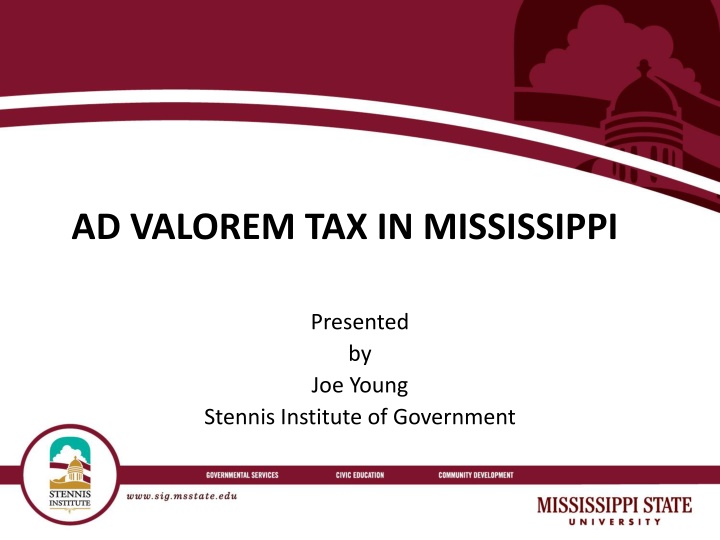



![Town of [Town Name] Real Estate Tax Rates and FY 2024 Budget Summary](/thumb/62211/town-of-town-name-real-estate-tax-rates-and-fy-2024-budget-summary.jpg)




